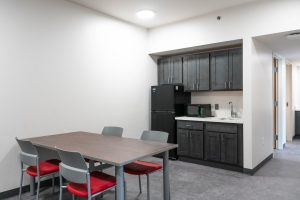OC Alumnus Counsels Students on Art, Post-Oberlin Careers
May 2, 2014
Composer, cultural producer and musician Nick Hallett, OC ’97, couldn’t stay away from Oberlin for too long. On Tuesday, April 29, he delivered a talk titled “The Impossible Convention: Hybrid Music-Art Practices in Gotham and Beyond,” which was sponsored by the Alumni Association and the Ellen Johnson Fund. Hallett described his art-making journey since his time as a double-degree student majoring in Linguistics and Vocal Performance at Oberlin.
Professor of Integrated Media Julia Christensen introduced Hallett to the group of College and Conservatory students. Throughout the spring semester, the Art department has invited manyOberlin alumni who currently work as artists to come speak to students who are hoping to follow a similar trajectory after graduation. Hallett explained what kind of a student he was while at Oberlin; he took particular interest in performance artists like Meredith Monk and Laurie Anderson, both known for expanding typical theater productions by intensely layering materials into multimedia collage. Hallett noted that he never took an art class at Oberlin, although his interest in interdisciplinary fields led him to his current career as a multimedia composer.
Hallett mapped out the projects that he has worked on in the 17 years since his graduation. In the early 2000s, Hallett and audiovisual artist Ray Sweeten formed an electropop band called The Plantains. The Plantains was an example of the emerging genre “electroclash” that reached the public eye in the early 2000s and blended new wave synthcore with 1990s electronic dance music. The Plantains played with prominent bands like Scissor Sisters and Le Tigre, and the scene surrounding electroclash music allowed Hallett to explore other aspects of the art scene that emphasized multimedia performance.
However, the music industry was not supportive of this new musical scene, and Hallett and his contemporaries began to consider electroclash a failed musical endeavor. Conversely, the art world eagerly encouraged the production and exhibition of more work of this kind. Representatives of the art scene noticed Hallett’s skills in organizing performance art shows and the diverse audiences he attracted, and the attention allowed Hallett to move into thecuratorial field within the art world.
Hallett worked as a curator at the renowned NYC nonprofit experimentalperformance space The Kitchen. In his curatorial practice, Hallett noted that he was “interested in understanding the oneto-one relationship of art and sound.” Theincorporation of sonic elements into visual art is not a new phenomenon, but the technological advances of the past 15 years have allowed it to be much more accessible to larger audiences. Hallett’s work implements musical and visual trends from the 1960s and 1970s and applies them to technological systems of the 21st century.
In his lecture, Hallett aimed to deconstruct his career choices in order to inform current students about what their futures may hold and to give informative advice. After working as a curator for several years, Hallett began to produce artistic work in the genre of new opera. His departure from both curatorial work and the mainstream music industry has allowed him to explore the different aspects of the art world by creating immersive artistic experiences. “The artist should not tap into the zeitgeist but rather the artist should be the zeitgeist,” Hallett said.
In collaboration with performance artist Shana Moulton, Hallett created the interdisciplinary opera Whispering Pines 10, which was staged at theSan Francisco Museum of Modern Art in 2012. The opera, which Hallett described as “an exploration of the polarity between high art and low kitsch,” continues to tour today, and Hallett and Moulton are working to make it available on the internet.
The lecture gave students a glimpse into the professional lifeof an artist who got his start as an Oberlin student. Hallett supplied pertinent advice to the room of eager Art, Art History, TIMARA and Composition students. He assured the audience members that they would have both successes and failures in their professional careers — but they should not be discouraged from applying risky, innovative ideas to art.

























